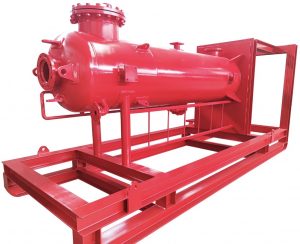Mud gas separator is commonly called a gas-buster or poor boy degasser, are a type of equipment used in the oil and gas drilling industry. There are various designs of mud gas separators. I am glad to share the following information with you and hope it will be helpful to you.
General information of mud gas separator
Mud gas separators facilitate the flow of drilling mud into their containers, while discharging the gas through the outlet pipe. The gas that had been separated was then safely transported out of the drilling area.
It typically comprises a cylindrical container and several internal components, such as an intake pipe, a baffle, and a fog extractor. The gas is typically discharged through a flare line or exhaust stack to safely dissipate.
There are 3 main models of AIPU mud gas separators. APMGS800, APMGS1000, APMGS1200. The difference between them is the vessel dia and the flow rate
mud gas separators
Yes, mud gas separators are widely used for different types of mud systems. Such as solids control for oil and gas, mud recycling for HDD, etc.
Features of APMGS
Sure, the degasser manufactured by AIPU is not just a high flow characteristic. Moreover, the degasser manufactured by AIPU has a high degassing efficiency, and this is really due to its large flow rate. In addition, the degasser manufactured by AIPU adopts a mud seal design, which can prevent gas backflow well. This feature safely vents isolated gases from the rig, minimizing the risk of potential hazards and maintaining a safe working environment.
Why choose Aipu ?
We are proud to serve clients all over the globe. Appreciated by clients since confidence they get from us. Some of clients visited our company, some of them were introduced by regular clients.
Essential reason, is our professional solutions. From discuss on condition detail, drawing we provided to quotation and after service. Only professional in deed will give them confidence on economical cost and high quality.
Custom built is always welcome at. Based on your budget and configuration you prefer, you will certainly get optimal proposal. Why not come to us now?




